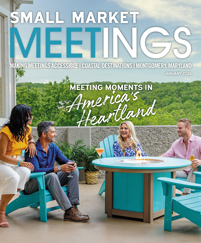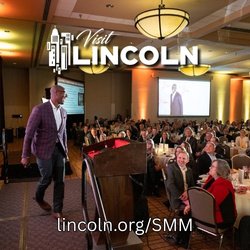History adds to any event’s ambience. That’s why planners seek historic destinations. Often, through their intricate architecture and links to important people and events, they remind of earlier times. Venues like grand mansions or historic textile mills add beauty or recall a different way of life.
Here are five meeting destinations across the country with history to share.
Santa Barbara, California
Santa Barbara, California, is sure to delight any history buff with a cultural mix that includes Spanish Mission and Moorish architecture and Hollywood glamor from the silent film era. The city’s historic institutions also pay homage to the story of the indigenous Chumash Native American tribes that roamed present-day Santa Barbara over 1,000 years ago. Historical settings like the Granada Theatre, where 100 attendees can dine on the historic stage, and the Santa Barbara County Courthouse, an operational courthouse with outdoor sunken gardens and a Mural Room that illustrates the city’s history, make excellent backdrops for off-site meetings.
“Groups should have meetings here because of the culture, history, and tapestry of experience in a small and accessible place,” said Beth Olsen, director of sales at Visit Santa Barbara. “When you bring your meeting here you feel like you’ve gone somewhere with a story to tell.”
In addition to its off-site venues, Santa Barbara’s traditional venues include two of its largest hotels, the Hilton Santa Barbara Beachfront Resort and The Ritz-Carlton Bacara, Santa Barbara. Both have 12,000-square-foot ballrooms and outdoor spaces that let attendees enjoy the warm climate. A host of smaller inns and boutique hotels handle overflow. Attendees can spend their downtime on the beach, go on a whale watching excursion or visit one of the region’s wineries.
Oxford, Mississippi
Founded in 1837, Oxford, Mississippi, was named for the prestigious university in England, with the hope it would be selected as the site of the state’s first public university. The scheme worked, and the University of Mississippi, nicknamed Ole Miss, opened in 1848. Thanks to telephone booths and a double decker bus, Oxford retains its symbolic ties to English life. And its appeal to history lovers doesn’t stop there; it was also home to legendary Southern Gothic author William Faulkner. His home, Rowan Oak, is now a museum, filled with relics from the author’s life. Other historic hotspots include the downtown square and the historic Lyric Oxford, a theater that can also serve as a venue.
“Oxford is very special,” said Nadia Thornton, marketing and sales manager at Visit Oxford Mississippi. “It’s the extracurricular things that set a destination apart. You have options for touring the University of Mississippi, sitting in The Grove, learning about Faulkner, or having a cocktail and a great meal from a James Beard Award-winning chef.”
The city has its share of modern meeting amenities too. The Oxford Conference Center recently underwent a $1 million cosmetic renovation to upgrade its 25,000 square feet of meeting space, which includes an 11,000-square-foot hall and a 280-seat auditorium. Three nearby hotels offer 280 hotel rooms. The 146-room Inn at Ole Miss, the city’s only full-service hotel, has 10,000 square feet of meeting space.
Amana Colonies, Iowa
Founded in 1855 by German immigrants who sought religious freedom, Iowa’s Amana Colonies comprise seven villages in eastern Iowa just south of Cedar Rapids. The colonies’ inhabitants lived communally for nearly 80 years and became known for their craftsmanship and self-sustaining, close-knit community. The Amana Colonies were designated a National Historic Landmark in 1965 and have been attracting tourists since.
Amana’s most prominent meeting space, Hotel Millwright, was created from part of its still-operational woolen mill, the last in Iowa. Known for its textiles, Amana still produces them today as an effort to preserve local history. The hotel original woodwork and modern finishes give it an eclectic feel and there are several historic meeting spaces to choose from, including the 1,000-square-foot Carding Studio and the 7,000-square-foot Merino Loft.
“With the modern space of Hotel Millwright, along with the history that’s within the community, people can come and have their event while experiencing the hospitality of the Amana Colonies,” said Keeley Degel, director of sales at Hotel Millwright.
Price Creek Event Center, also in Amana, is another rustic venue that does its own catering. Other points of interest nearby are the Millstream Brewing Company, Iowa’s first craft brewery, and Amana’s General Store. Planners can arrange for step-on guides to join groups for a history-themed bus tour of the seven colonies after their meeting.
Newport, Rhode Island
Though New England overflows with historic destinations, few allow attendees to experience their past quite like Newport, Rhode Island. This walkable coastal gem was founded by English settlers in 1639 and officially incorporated in 1784, but much of its historic appeal comes from the Gilded Age when extremely wealthy families built luxurious mansions there. Some of them can be booked for events, including the popular Rosecliff, built in 1902.
“Off-site venues are really what sets Newport apart,” said Alex Hurd, director of sales at Discover Newport. “Nobody’s building Gilded Age mansions anymore. And it’s not just touring — you get to experience what the houses were built for: entertainment.”
Because Newport was a significant port city, there’s also a ton of maritime history to experience. Groups can sail on 12-meter yachts or have an event at the Sailing Museum. Other favorite off-site venues include the city’s wineries, car museums and the International Tennis Hall of Fame, which celebrates the sport’s history in Newport and around the world.
Several convention hotels are located downtown and on the waterfront. Downtown, the historic 208-room Hotel Viking offers 14,000 square feet of meeting space. The Newport Marriott Resort and Spa, Newport Beach Hotel and Suites and Newport Harbor Island Resort can host meetings on the water.
Las Cruces, New Mexico
Surrounded by the Chihuahuan Desert, Las Cruces, New Mexico, has millennia of history to share. Indigenous tribes are believed to have first lived there at least 23,000 years ago. In the last five centuries, the Spanish conquistadors arrived, the United States and Mexico fought over territory, Las Cruces was founded and American settlers arrived.
The region has a long agricultural history, and one venue that showcases it is the New Mexico Farm and Ranch Heritage Museum. In addition to a courtyard and several indoor spaces, the museum has ranching activities that groups can try. Nearby, the historic town of Mesilla is anchored by the historic Basilica of San Albino and retains the appearance of a border town in the 1800s. The park and plaza can be rented for outdoor events.
In downtown Las Cruces, near the campus of New Mexico State University, the LEED-certified Las Cruces Convention Center has a 17,000- -square-foot exhibit hall, a 9,000-square-foot ballroom and 10 breakout rooms, as well as indoor and outdoor pre-function spaces. Meeting hotels and resorts include a Ramada Hotel and Conference Center, with 6,800 square feet of meeting space, and the Hotel Encanto de Las Cruces, with 35,000 square feet of indoor and outdoor event space.
After the meeting, attendees will love exploring natural wonders like the Organ Mountains, the Rio Grande and White Sands National Park. They might also catch one of the city’s many multicultural festivals.












